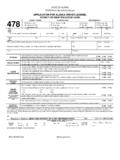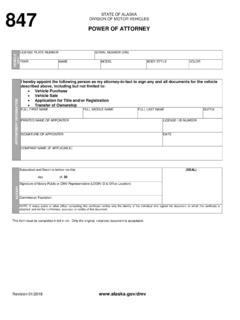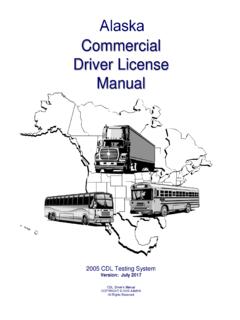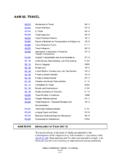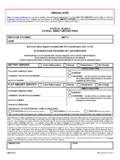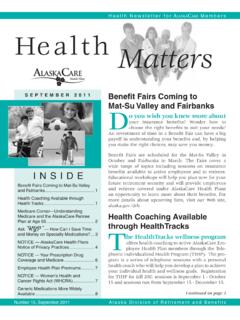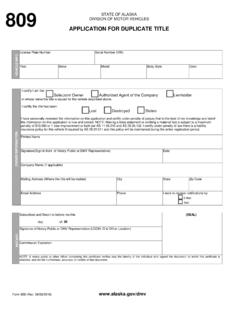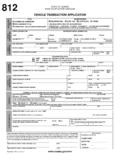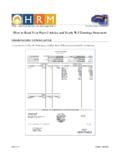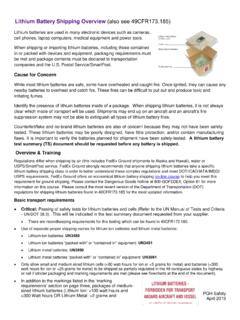Transcription of PREPARED BY ALASK A DEPARTMENT OF ADMINISTR ATION …
1 PREPARED BY. alaska DEPARTMENT . OF ADMINISTRATION. DIVISION OF MOTOR VEHICLES. State of alaska MOTORCYCLE MANUAL. This publication was released by the alaska DEPARTMENT of Administration, Division of Motor Vehicles at a cost of $ per copy and printed in Anchorage, alaska . Please help reduce the cost of state government by returning the manual or passing it on to another future driver. The purpose of this manual is to provide the reader with a general familiarity with the principles of safe and lawful operation of a motorcycle. The contents of this manual are NOT intended to serve as a precise statement of the Statutes and Regulations of the State of alaska pertaining to the operation of a motorcycle, and should not be understood by the reader as such. REV. 2/15. Printed 2/15. i PREFACE.
2 Operating a motorcycle safely in traffic requires special skills and knowledge. This manual, with the cooperation of the Motorcycle Safety Foundation, is made available to help novice motorcyclists reduce their risk of having a crash. The content of this manual was updated and expanded by the Motorcycle Safety Foundation from the original version. The original version was developed by the National Public Research Institute under contract to the National Highway Traffic Safety Administration with the cooperation of the Motorcycle Safety Foundation. alaska requires the operator of any motorcycle with an engine displacement of 50cc or more to have a Class M1 or M3 license in addition to the regular license. The M1 license is valid for all sizes and is available only to individuals who are 16 years of age or older.
3 motorcycles and motor scooters with engine displacement of less than 50cc can be operated with a basic driver license. A Class M2 license allows an applicant who is 14 or 15. years of age to operate a motor-driven cycle, motor-scooter, motorized bicycles, or similar conveyance with a motor attached and having an engine with less than 50 cc displacement. A Class M3 license allows the operation of three-wheeled motorcycles (trike), three wheeled motor-driven cycles, and three-wheeled motorized bicycles with an engine displacement of 50 cc or more, single or in combination with a trailer designed to be used with these vehicles. An applicant for an M1, M2, or M3 license may have the testing requirements waived by completing a Motorcycle Safety Foundation Course and presenting the completion certificate to DMV.
4 The certificate is valid to waive the road test for one year. The MSF. scooter test is not valid for waiving the road test. If you are under 18 years of age and obtaining your first driver or M1 or M3 license, you must have held a permit for 6 months prior to obtaining your provisional license. Please refer to the basic driver manual for more information on provisional driver licenses. An applicant for an M1, M2, or M3 license will be required to pass two written tests and a road skill test. The first test will deal with the basic rules of the road (this test is waived if the applicant has a valid license or instruction permit). The second test is a motorcycle written test based on the information found in this manual. After passing the written tests, applicants will be required to pass a road skills test.
5 The applicant will be required to wear a helmet. All applicants must wear eye protection if there is not a windshield on the motorcycle used for the road skills test. Applicants must provide the motorcycle, helmet, and eye protection. The motorcycle used for testing must be appropriate for the class of license being sought. An M1 or M3 license requires that you use a motorcycle with an engine displacement of 50cc or more. Testing in a motorcycle with a sidecar qualifies for an M3 only. Mandatory insurance and financial responsibility laws do apply to the operation of motorcycles of all types. Please refer to the basic driver manual for more information. The object of this manual is to prepare applicants for a motorcycle license to take the required tests, and to help reduce the number of motorcycle crashes.
6 We hope you will use this manual as an aid in safe and enjoyable riding. State of alaska Division of Motor Vehicles ii A Message from the Highway Safety Planning Agency The increased popularity of motorcycle use in alaska is substantiated by the increase in motorcycle registrations and motorcycle operator licenses. This popularity is also reflected by the increase in motorcycle deaths and injuries upon our roadways. As you know, the motorcycle rider has several disadvantages when operating in traffic. Some of these include the instability of a two-wheel vehicle, low visibility in traffic situations, and the lack of protective devices. The majority of serious motorcycle injuries and deaths are the direct result of a head injury. The importance of wearing an approved motorcycle helmet cannot be overstressed.
7 We urge you to enjoy your motorcycle and to have a safe ride by driving defensively, use your headlight at all times, and most importantly, wear your helmet. Items to consider when driving a vehicle other than a motorcycle: motorcycles are vehicles with the same rights and privileges as any vehicle on the roadway. Allow the motorcyclist a full lane width. Although it may seem as though there is enough room in the traffic lane for an automobile and a motorcycle, remember the motorcycle needs room to maneuver safely. Do not share the lane. Approximately one-half of all motorcycle crashes involve another motor vehicle. Nearly 40 percent were caused by the other vehicle turning left in front of the motorcyclist. motorcycles are small and may be difficult to see. motorcycles have a much smaller profile than vehicles, which can make it more difficult to judge the speed and distance of an approaching motorcycle.
8 Always signal your intentions before changing lanes or merging with traffic. This allows the motorcyclist to anticipate traffic flow and find a safe lane position. Remember that motorcyclists are often hidden in a vehicle's blind spot or missed in a quick look due to their smaller size. Always make a visual check for motorcycles by checking mirrors and blind spots before entering or leaving a lane of traffic and at intersections. Don't be fooled by a flashing turn signal on a motorcycle motorcycle signals usually are not self-cancelling and riders sometimes forget to turn them off. Wait to be sure the motorcycle is going to turn before you proceed. Remember that road conditions which are minor annoyances to you pose major hazards to motorcyclists. Motorcyclists may suddenly change speed or adjust their position within a lane in reaction to road and traffic conditions such as potholes, gravel, wet or slippery surfaces, pavement seams, railroad crossings, and grooved pavement.
9 Allow more distance three or four seconds - following a motorcycle so the motorcyclist has enough time to maneuver or stop in an emergency. In dry conditions, a motorcycle can stop more quickly than a car. Cars Alongside .. 20. iv TABLE OF CONTENTS. PREPARING TO 1. WEAR THE RIGHT GEAR .. 1. The Helmet .. 1. Helmet Selection .. 2. Eye and Face Protection .. 2-3. Clothing .. 3. CHECK THE MOTORCYCLE .. 3. While Walking to the Cycle .. 4. While Sitting on the 4. GET FAMILIAR WITH THE MOTORCYCLE .. 5. CONTROL FOR SAFETY .. 5. BODY POSITION .. 6. TURNING .. 6. BRAKING .. 6. SHIFTING GEARS .. 7. Downshifting .. 7. Shifting for a Turn .. 7. Starting Uphill .. 7. BEING SEEN .. 8. CLOTHING .. 8. HEADLIGHT .. 8. SIGNALS .. 8. Turn Signals .. 8-9. POSITION FOR BEING SEEN .. 10. Stay Out of Blind Spots.
10 10-11. Let the Driver Ahead See You .. 11. Help Drivers at Intersections See 11-12. HORN .. 12. LOOKING FOR TROUBLE .. 13. THE ROAD 13. USING YOUR 13-14. HEAD 14. POSITION TO SEE .. 15. KEEPING YOUR DISTANCE .. 17. DISTANCE IN FRONT .. 17. DISTANCE TO THE 17. Passing Vehicles .. 17-18. Cars at 18. Parked 19. Lane Sharers .. 19. Merging Vehicles .. 20. Cars Alongside .. 20. iv DISTANCE 20. HANDLING 20. SLIPPERY SURFACES .. 20-21. Handling Slippery Surfaces .. 21. Very Slippery Surfaces .. 21. UNEVEN SURFACES AND OBSTACLES .. 22. RAILROAD 22-23. GROOVES AND GRATINGS .. 24. RIDING AT NIGHT .. 25. DEALING WITH EMERGENCIES .. 25. QUICK STOPS .. 25-26. QUICK 26. MECHANICAL PROBLEMS .. 26-27. Tire Failure .. 27. Stuck Throttle .. 27. Wobble .. 27-28. Engine Seizure .. 28. GETTING OFF THE ROAD.
